形容词和副词比较级和最高级的用法
形容词及副词的比较级和最高级的用法

比较级和最高级一、形容词比较级和最高级的规则其它不规则的变化:二、形容词比较级基本用法1、与than搭配的基本形式(1)名词/代词He is older than me.(2) 动名词/从句Skiing is more exciting than skating.(3) 状语/动词/形容词/副词①much/a lot/ a bit/ a little/ slightly/any/ no/ even/ some/ stillEg: She is feeling a lot/much better today.Do you feel any better today?She is no older than mike.②数词My sister is ten years younger than me.2、特殊搭配1)“比较级+and+比较级”表示“越来越……”eg: He becomes fatter and fatter. She is growing more and more beautiful2)“The +比较级…,the +比较级”表示“越……,越……”The busier he is ,the happier he feels3)表示两者中”较……“时,用the + 形容词比较级+ of 短语来表达。
He is the taller of the two.4)在含有or的选择疑问句中,如果有两者供选择,前面的形容词要用比较级形式。
5)More ...than...的几种用法和含义①more B than A = less A than B. He is more lazy than slow at his work= he is less slow than lazy at his work.②no/not any more/less… than…两个都不(neither)③More than不仅仅是,no Less than(不)少于,more or less 差不多The work is more or less finished.one more=another more Any other+名词单数(名词可以省略)3、修饰比较级的词①a bit, a little, rather, much,far, by far, many, a lot, lots, a great deal, any, still, even(very只修饰原级)②用表示倍数的词或度量名词作修饰语。
形容词副词的比较级和最高级与用法
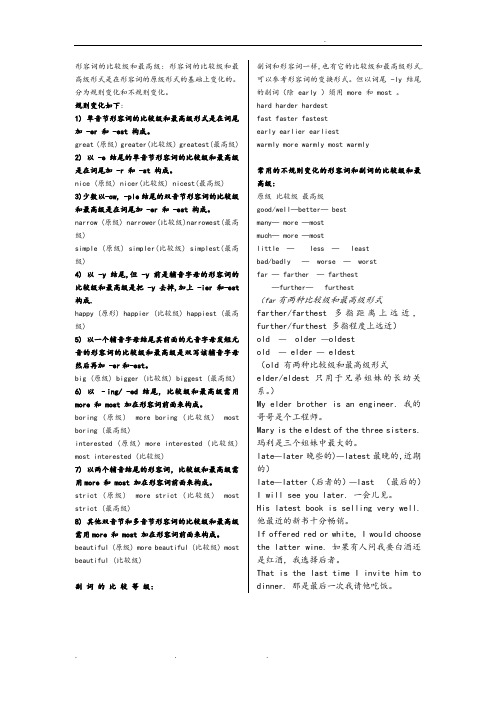
形容词的比较级和最高级: 形容词的比较级和最高级形式是在形容词的原级形式的基础上变化的。
分为规则变化和不规则变化。
规则变化如下:1) 单音节形容词的比较级和最高级形式是在词尾加 -er 和 -est 构成。
great (原级) greater(比较级) greatest(最高级) 2) 以 -e 结尾的单音节形容词的比较级和最高级是在词尾加 -r 和 -st 构成。
nice (原级) nicer(比较级) nicest(最高级)3)少数以-ow, -ple结尾的双音节形容词的比较级和最高级是在词尾加 -er 和 -est 构成。
narrow (原级) narrower(比较级)narrowest(最高级)simple (原级) simpler(比较级) simplest(最高级)4) 以 -y 结尾,但 -y 前是辅音字母的形容词的比较级和最高级是把 -y 去掉,加上 -ier 和-est 构成.happy (原形) happier (比较级) happiest (最高级)5) 以一个辅音字母结尾其前面的元音字母发短元音的形容词的比较级和最高级是双写该辅音字母然后再加 -er和-est。
big (原级) bigger (比较级) biggest (最高级) 6) 以–ing/ -ed结尾, 比较级和最高级需用more 和 most 加在形容词前面来构成。
boring (原级) more boring (比较级) most boring (最高级)interested (原级) more interested (比较级) most interested (比较级)7) 以两个辅音结尾的形容词,比较级和最高级需用more 和 most 加在形容词前面来构成。
strict (原级) more strict (比较级) most strict (最高级)8) 其他双音节和多音节形容词的比较级和最高级需用more 和 most 加在形容词前面来构成。
形容词副词的比较级和最高级的变化规则及用法(完美版)
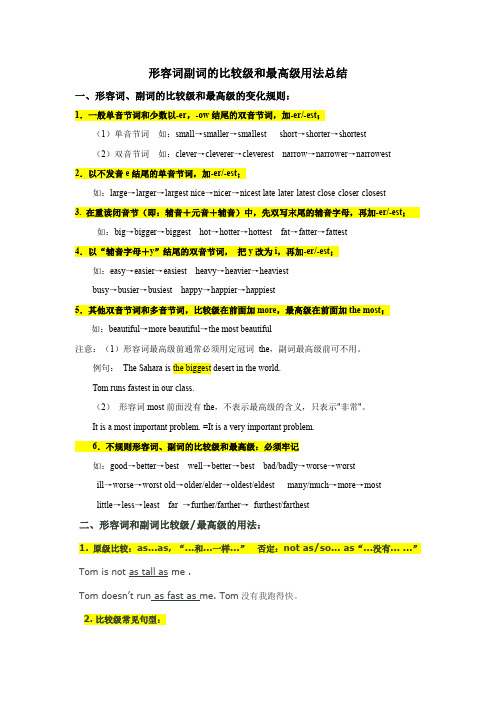
形容词副词的比较级和最高级用法总结一、形容词、副词的比较级和最高级的变化规则:1.一般单音节词和少数以-er,-ow结尾的双音节词,加-er/-est;(1)单音节词如:small→smaller→smallest short→shorter→shortest(2)双音节词如:clever→cleverer→cleverest narrow→narrower→narrowest2.以不发音e结尾的单音节词,加-er/-est;如:large→larger→largest nice→nicer→nicest late-later-latest close-closer-closest3. 在重读闭音节(即:辅音+元音+辅音)中,先双写末尾的辅音字母,再加-er/-est;如:big→bigger→biggest hot→hotter→hottest fat→fatter→fattest4.以“辅音字母+y”结尾的双音节词,把y改为i,再加-er/-est;如:easy→easier→easiest heavy→heavier→heaviestbusy→busier→busiest happy→happier→happiest5.其他双音节词和多音节词,比较级在前面加more,最高级在前面加the most;如:beautiful→more beautiful→the most beautiful注意:(1)形容词最高级前通常必须用定冠词the,副词最高级前可不用。
例句:The Sahara is the biggest desert in the world.Tom runs fastest in our class.(2)形容词most前面没有the,不表示最高级的含义,只表示"非常"。
It is a most important problem. =It is a very important problem.6.不规则形容词、副词的比较级和最高级:必须牢记如:good→better→best well→better→best bad/badly→worse→worstill→worse→worst old→older/elder→oldest/eldest many/much→more→mostlittle→less→least far →further/farther→furthest/farthest二、形容词和副词比较级/最高级的用法:1. 原级比较:as...as, “...和...一样...”否定:not as/so... as“...没有... ...”Tom is not as tall as me .Tom doesn’t run as fast as me. Tom没有我跑得快。
形容词和副词比较级和最高 级的用法
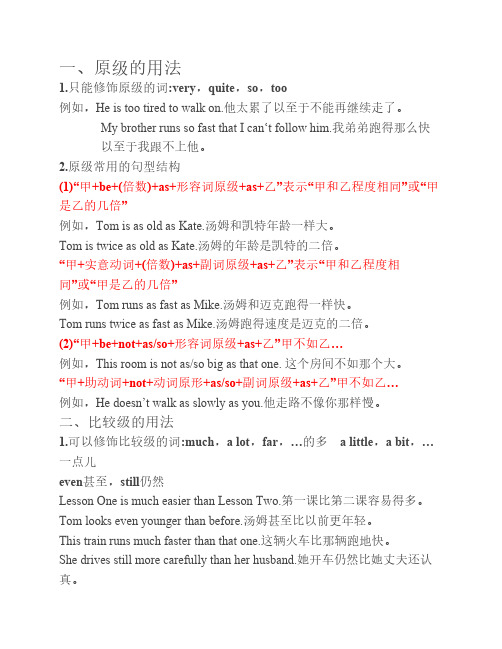
一、原级的用法1.只能修饰原级的词:very,quite,so,too例如,He is too tired to walk on.他太累了以至于不能再继续走了。
My brother runs so fast that I can‘t follow him.我弟弟跑得那么快以至于我跟不上他。
2.原级常用的句型结构(1)“甲+be+(倍数)+as+形容词原级+as+乙”表示“甲和乙程度相同”或“甲是乙的几倍”例如,Tom is as old as Kate.汤姆和凯特年龄一样大。
Tom is twice as old as Kate.汤姆的年龄是凯特的二倍。
“甲+实意动词+(倍数)+as+副词原级+as+乙”表示“甲和乙程度相同”或“甲是乙的几倍”例如,Tom runs as fast as Mike.汤姆和迈克跑得一样快。
Tom runs twice as fast as Mike.汤姆跑得速度是迈克的二倍。
(2)“甲+be+not+as/so+形容词原级+as+乙”甲不如乙…例如,This room is not as/so big as that one. 这个房间不如那个大。
“甲+助动词+not+动词原形+as/so+副词原级+as+乙”甲不如乙…例如,He doesn’t walk as slowly as you.他走路不像你那样慢。
二、比较级的用法1.可以修饰比较级的词:much,a lot,far,…的多 a little,a bit,…一点儿even甚至,still仍然Lesson One is much easier than Lesson Two.第一课比第二课容易得多。
Tom looks even younger than before.汤姆甚至比以前更年轻。
This train runs much faster than that one.这辆火车比那辆跑地快。
She drives still more carefully than her husband.她开车仍然比她丈夫还认真。
形容词和副词比较级和最高级的用法总结

“甲+情态动词+not+实意动词原形+as/so+副词原级+as+乙”甲不如乙…例如,He doesn’t walk as slowly as you.他走路不像你那样慢。
二、比较级的用法1.可以修饰比较级的词:much,a lot,far,a great deal…的多; a little,a bit,…一点儿;even甚至,still仍然Lesson One is much easier than Lesson Two.第一课比第二课容易得多。
Tom looks even younger than before.汤姆甚至比以前更年轻。
This train runs much faster than that one.这辆火车比那辆跑地快。
She drives still more carefully than her husband.她开车仍然比她丈夫还认真。
2.比较级常用的句型结构(1)“甲+be+(倍数)+形容词比较级+than+乙”表示“甲比乙…”或“甲比乙…几倍”例如,Tom is taller than Kate.汤姆比凯特高。
This room is three times bigger than that one.这个房间比那个大三倍。
“甲+实意动词+(倍数)+副词比较级+than+乙”表示“甲比乙…”或“甲比乙…几倍”例如,I got up earlier than my mother this morning.我今天早晨起床比我妈妈还早。
He runs three times faster than his brother.他跑的速度比他弟弟快三倍。
“甲+情态动词+实意动词原形+(倍数)+副词比较级+than+乙”表示“甲比乙…”或“甲比乙…几倍”(2)“甲+be+形容词比较级+than+any other+单数名词(+介词短语)”表示“甲比同一范围的任何一个人/物都……”,含义是“甲最……”。
形容词与副词的比较级与最高级形式与用法
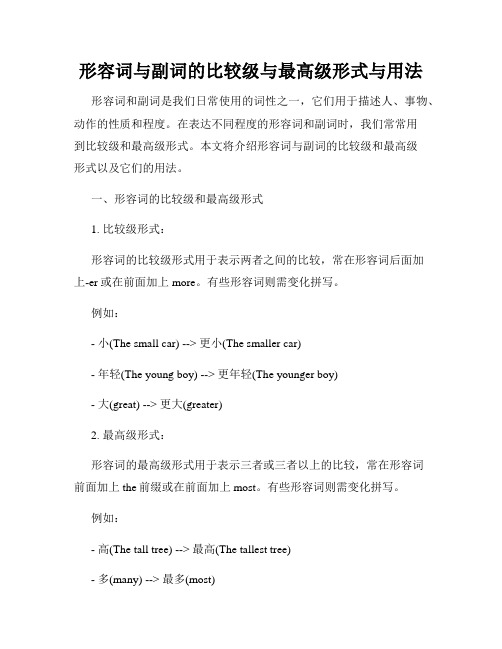
形容词与副词的比较级与最高级形式与用法形容词和副词是我们日常使用的词性之一,它们用于描述人、事物、动作的性质和程度。
在表达不同程度的形容词和副词时,我们常常用到比较级和最高级形式。
本文将介绍形容词与副词的比较级和最高级形式以及它们的用法。
一、形容词的比较级和最高级形式1. 比较级形式:形容词的比较级形式用于表示两者之间的比较,常在形容词后面加上-er或在前面加上more。
有些形容词则需变化拼写。
例如:- 小(The small car) --> 更小(The smaller car)- 年轻(The young boy) --> 更年轻(The younger boy)- 大(great) --> 更大(greater)2. 最高级形式:形容词的最高级形式用于表示三者或三者以上的比较,常在形容词前面加上the前缀或在前面加上most。
有些形容词则需变化拼写。
例如:- 高(The tall tree) --> 最高(The tallest tree)- 多(many) --> 最多(most)二、副词的比较级和最高级形式1. 比较级形式:副词的比较级形式与形容词相同,可以在后面加上-er或在前面加上more。
例如:- 快(He runs fast) --> 更快(He runs faster)- 悄悄地(Quietly) --> 更悄悄地(More quietly)2. 最高级形式:副词的最高级形式也与形容词相同,可以在前面加上most或在副词前面加上the前缀。
例如:- 很(nicely) --> 最(nicest)- 积极地(actively) --> 最积极地(the most actively)三、形容词和副词比较级与最高级的用法1. 更有多样性的比较:有些形容词和副词在比较级和最高级形式中有特殊变化。
例如:- 好(good) --> 更好(better) --> 最好(the best)- 多(多种方式)(many)--> 更多(more) --> 最多(the most)2. 不规则比较:有一些形容词和副词的比较级和最高级形式变化不规则,需特别注意。
形容词与副词的比较级与最高级用法
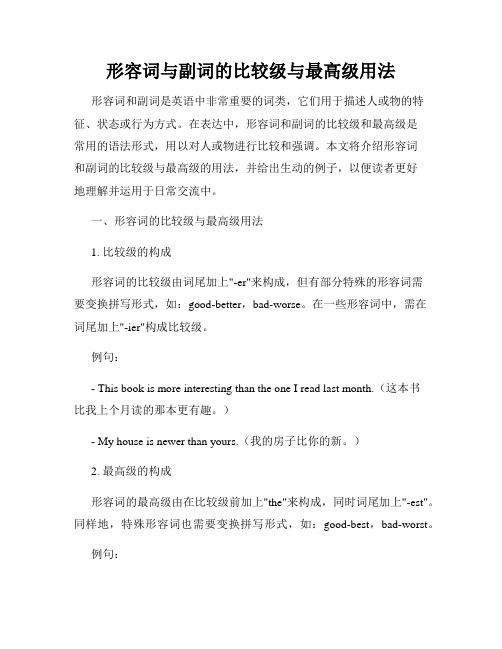
形容词与副词的比较级与最高级用法形容词和副词是英语中非常重要的词类,它们用于描述人或物的特征、状态或行为方式。
在表达中,形容词和副词的比较级和最高级是常用的语法形式,用以对人或物进行比较和强调。
本文将介绍形容词和副词的比较级与最高级的用法,并给出生动的例子,以便读者更好地理解并运用于日常交流中。
一、形容词的比较级与最高级用法1. 比较级的构成形容词的比较级由词尾加上"-er"来构成,但有部分特殊的形容词需要变换拼写形式,如:good-better,bad-worse。
在一些形容词中,需在词尾加上"-ier"构成比较级。
例句:- This book is more interesting than the one I read last month.(这本书比我上个月读的那本更有趣。
)- My house is newer than yours.(我的房子比你的新。
)2. 最高级的构成形容词的最高级由在比较级前加上"the"来构成,同时词尾加上"-est"。
同样地,特殊形容词也需要变换拼写形式,如:good-best,bad-worst。
例句:- This is the most beautiful flower I have ever seen.(这是我见过的最美丽的花。
)- He is the smartest student in our class.(他是我们班最聪明的学生。
)3. 比较级与最高级的用法- 形容词的比较级常用于两个人或物的比较。
例句:- John is taller than his brother.(约翰比他的弟弟高。
)- This dress is more expensive than that one.(这件连衣裙比那件贵。
)- 形容词的最高级用于三个或三个以上人或物的比较。
例句:- Mary is the oldest of the three sisters.(玛丽是三个姐妹中最年长的一个。
形容词和副词的比较级与最高级用法
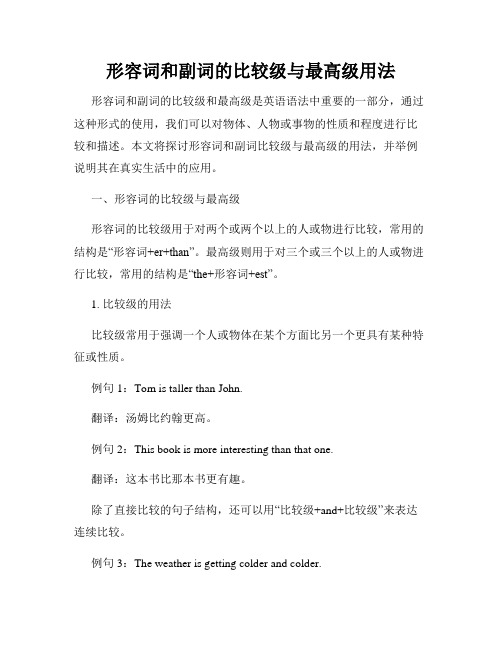
形容词和副词的比较级与最高级用法形容词和副词的比较级和最高级是英语语法中重要的一部分,通过这种形式的使用,我们可以对物体、人物或事物的性质和程度进行比较和描述。
本文将探讨形容词和副词比较级与最高级的用法,并举例说明其在真实生活中的应用。
一、形容词的比较级与最高级形容词的比较级用于对两个或两个以上的人或物进行比较,常用的结构是“形容词+er+than”。
最高级则用于对三个或三个以上的人或物进行比较,常用的结构是“the+形容词+est”。
1. 比较级的用法比较级常用于强调一个人或物体在某个方面比另一个更具有某种特征或性质。
例句1:Tom is taller than John.翻译:汤姆比约翰更高。
例句2:This book is more interesting than that one.翻译:这本书比那本书更有趣。
除了直接比较的句子结构,还可以用“比较级+and+比较级”来表达连续比较。
例句3:The weather is getting colder and colder.翻译:天气越来越冷。
2. 最高级的用法最高级用于强调一个人或物在某个方面超过其他所有人或物,是比较级的最高级形式。
例句4:He is the tallest boy in the class.翻译:他是班里最高的男孩。
例句5:This is the most delicious cake I have ever tasted.翻译:这是我尝过的最美味的蛋糕。
二、副词的比较级与最高级与形容词类似,副词的比较级和最高级也是用于对两个或两个以上的动作或状态进行比较和描述的。
常用的结构是“副词+er+than”和“the+副词+est”。
1. 比较级的用法副词的比较级用于对两个或两个以上的动作或状态进行程度上的比较。
例句6:He speaks English more fluently than his sister.翻译:他说英语比他妹妹更流利。
形容词副词比较级最高级及用法

IV. Others ①表示不及另一方时,使用“less+原级+than…”
+n. This park is less beautiful than that one. ②比较级和最高级互换(比较时要把自己排除在外。注意比较的范围)
eg. Shanghai is the largest city in China. Shanghai is larger than any other city in China. Shanghai is larger than any city in Africa. Ex: John is the thinnest student in the class. John is thinner than any other student in the class.
4. 汉语比英语难的多. Chinese is much more difficult than English. 5. 他比你跑地快一点儿. He runs a little faster than you. 6. 我父亲比我母亲年长三岁. My father is four three older than my mother. 比较级前可用表示程度的副词修饰,如 a little, a bit ,much ,a lot, even ,four years old等
John is thinner than ③ ** adj.&adv: hard, fast, early, late, high, etc.
in the class.
Task 2 形容词和副词的比较级
1. 我比你瘦. I am thinner than you. 2. 我摘的苹果比你少. I picked fewer apples than you (did). 3. 中国印度.哪个国家更大? Which country is larger,China or India? 4. 我认为语文比数学更有趣. I think Chinese is more interesting than maths.
形容词和副词比较级和最高级的用法总结

形容词和副词比较级和最高级的用法总结1.比较级的构成:形容词/副词的比较级通常在原词后面加上"-er"或者在前面加上"more",如:taller, more beautiful。
不规则变化的比较级词有:good-better, bad-worse, far-further/farther。
2.最高级的构成:形容词/副词的最高级通常在原词后面加上"-est"或者在前面加上"most",如:tallest, most beautiful。
不规则变化的最高级词有:good-best, bad-worst, far-furthest/farthest。
3.比较级和最高级的使用:a.对比两个人或事物时,用于比较它们之间的程度或大小。
例:She is taller than me.(她比我高。
)b.用于句子中表示不同程度的形容词或副词。
例:He runs faster than his brother.(他跑得比他弟弟快。
)c.用于句子中表示同一事物在不同时间或情况下的变化。
例:She is getting more and more beautiful.(她变得越来越漂亮。
)d.用于表示最高程度的形容词或副词。
例:He is the tallest boy in the class.(他是班上最高的男孩。
)4.注意事项:a. 一些形容词和副词的比较级和最高级形式与原形相同,只需要在前面加上"more"或"most"来表示比较级和最高级。
例:brave - braver - bravest , more brave - most braveb.使用比较级时,必须与被比较的人或事物进行比较,不能单独使用。
例:She is taller.(错误)应改为 She is taller than him.(她比他高。
形容词、副词的比较级与最高级用法详解精选全文完整版

可编辑修改精选全文完整版形容词、副词的比较级与最高级用法详解一、形容词、副词比较级、最高级构成大多数的形容词、副词都具有原级、比较级和最高级三种形式。
而形容词、副词的比较级、最高级构成方式分规则变化和不规则变化。
其规则变化的方式详见下面个表:(一)规则变化:(1) 直接在词尾加-er, -est(2) 以不发音字母e 结尾的,在词尾加-r , -st(3)以“辅音字母+y“结尾的,把y 变i,再加-er , -est(4) 以辅音字母结尾的重读闭音节词汇,双写最后一个辅音字母,再加-er , -est(5) 部分双音节和多音节词,在其前加more, most(二)、不规则变化:比较级、最高级具有不规则变化形式的形容词和副词比较少,因此,需要大家逐一认真记忆。
详见下表:【妙记顺口溜】“坏”“病”两“多”和两“好”,一是“远”来,二是“老”,little 是“少”不是“小”。
二、形容词、副词比较级和最高级用法(一)形容词、副词比较级用法形容词、副词的比较级主要对两个的人或物在某种程度、性质上进行比较。
常见的形容词副词比较级用法如下:1.同级比较① A+be/v+as+原级+as+B A和B一样This room is as large as that one .这间房子和那间一样大(形容词)Tom writes as carefully as Kate.汤姆写字跟凯特一样认真。
(副词)②A+be/V+not+as(so)+级+as +B A 不如BTigers aren't as(so) dangerous as lions.老虎不如狮子危险。
(形容词)Mary didn't finish the work as(so) well as Lucy.玛丽完成这项工作不如露西好。
(副词)2.差极比较①A+be/v+比较级+B A比B更......This pen is newer than that one.这支钢笔比那支新。
(完整版)形容词和副词的比较级和最高级全面解析

形容词和副词的比较级和最高级形容词和副词的比较级和最高级的用法是初二上册新教材的重要考点,同时也是中考必须掌握的重要内容。
本文主要从形容词副词比较等级的变化、用法、及易错点三大方面对相关知识点进行详细解析,希望对同学们有所帮助。
一. 形容词和副词的比较级和最高级的变化方法如下:(1) 规则变化表:(2)几个不规则的形容词和副词的比较级和最高级如下表:二.形容词和副词比较级的基本用法注:如果动词是及物或不及物动词,则后面用副词;如果后面是连系动词,则后面用形容词。
如:This car is the fastest of the four.(形容词)(这辆汽车是四辆之中最快的) This car runs (the) fastest of the four.(副词)(这辆汽车是四辆之中跑得最快的)三.形容词副词比较级最高级的特殊用法(1)和冠词连用the +形容词原级+v(复),指一类人或物the + 形容词比较级,指两者中“较…的”的那一个,eg. the younger of the two a/ an +形容词比较级eg. The pen is expensive. I want a cheaper one. ( a) +most +形容词最高级 “非常…” eg. a most beautiful city (2)序数词与最高级连用,如:Flying is the fastest and the second cheapest way to travel. (3)比较级+than any other +n. (单) (适用于范围一致时)(all) other +n.(复)any +n.(单) (适用于范围不一致时) He is taller than any other student / all other students in his class. any student in my class. (4)倍数表达法。
形容词副词比较级,最高级用法
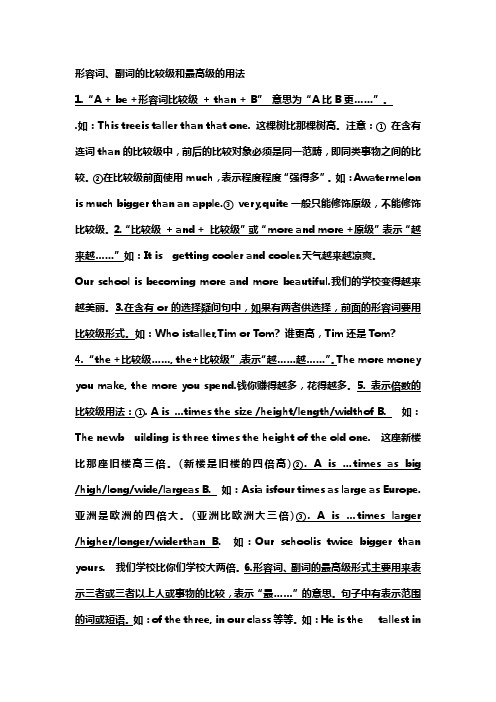
形容词、副词的比较级和最高级的用法.如:This treeis taller than that one. 这棵树比那棵树高。
注意:①在含有连词than的比较级中,前后的比较对象必须是同一范畴,即同类事物之间的比较。
②在比较级前面使用much,表示程度程度“强得多”。
如:Awatermelon is much bigger than an apple.③very,quite一般只能修饰原级,不能修饰Our school is becoming more and more beautiful.我们的学校变得越来The newb uilding is three times the height of the old one. 这座新楼Mike is the most intelligent in his class.=Mike is more intelligent较级的词①.a bit, alittle, rather, much, far, by far, many, a lot, lots, a great deal, any, still,even等。
②. 还可以用表示倍数的词或度量名词作修饰语。
③. 以上词(除by far)外,必须置于比较级形容词或副词的前面。
注意:使用最高级要注意将主语包括在比较范围内。
(错) Tom is the tallest of his three brothers. (对) Tom is the tallest of the three brothers.2)下列词可修饰最高级:by far, far, much, mostly,almost。
This hat is nearly / almost the biggest.注意: a. very可修饰最高级,但位置与much不同。
This is the very best. This is much the best.b. 序数词通常只修two sisters. She is the taller of the two sisters.。
形容词和副词的比较级最高级用法讲解

发音
有些形容词的比较级和最高级用—er和 --est 或 more和 most皆可,如:clever , lovely 等. 表示“较不……“和”最不……“时,可用less与least.
difficult Interesting
less difficult less interesting
lea、形容词比较级前可加数词,表示 “大(小)…多少” “长(短)…多少” eg:He is five years younger than me. 他比我小五岁。
10、表示倍数时用:…times+比较级+than… eg:My room is three times bigger than yours.
7/10/2014
原级常用的句型结构
1.表示比较双方程度不同时常用“not as/ so +形容词/副词 +as”结构,意为“….不如…” =less +原级结构示表示降级的比较级.意为“……不如……”. He is not as (so) tall as Lilei=He is less tall than Lilei. She does not study so well as I do=She studies less well than I. 2. 在同级比较中可以在第一个as前加half,twice,three/four times 等词来表示倍数关系 Their school is three times as large as ours.
另:在一定的上下文中,形容词最高级后面的名词可省去处 eg: He is the youngest in the class.
7/10/2014
三、形容词和副词比较级的用 法 1.表示两者之间的选择 ,
形容词、副词的比较级和最高级的用法
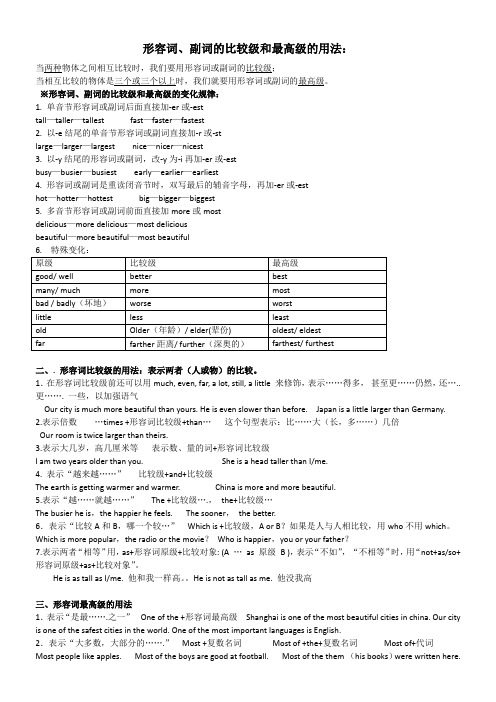
形容词、副词的比较级和最高级的用法:当两种物体之间相互比较时,我们要用形容词或副词的比较级;当相互比较的物体是三个或三个以上时,我们就要用形容词或副词的最高级。
※形容词、副词的比较级和最高级的变化规律:1. 单音节形容词或副词后面直接加-er或-esttall—taller—tallest fast—faster—fastest2. 以-e结尾的单音节形容词或副词直接加-r或-stlarge—larger—largest nice—nicer—nicest3. 以-y结尾的形容词或副词,改-y为-i再加-er或-estbusy—busier—busiest early—earlier—earliest4. 形容词或副词是重读闭音节时,双写最后的辅音字母,再加-er或-esthot—hotter—hottest big—bigger—biggest5. 多音节形容词或副词前面直接加more或mostdelicious—more delicious—most deliciousbeautiful—more beautiful—most beautiful二、. 形容词比较级的用法:表示两者(人或物)的比较。
1.在形容词比较级前还可以用much, even, far, a lot, still, a little 来修饰,表示……得多,甚至更……仍然,还…..更……. 一些,以加强语气Our city is much more beautiful than yours. He is even slower than before. Japan is a little larger than Germany. 2.表示倍数…times +形容词比较级+than…这个句型表示:比……大(长,多……)几倍Our room is twice larger than theirs.3.表示大几岁,高几厘米等表示数、量的词+形容词比较级I am two years older than you. She is a head taller than I/me.4. 表示“越来越……”比较级+and+比较级The earth is getting warmer and warmer. China is more and more beautiful.5.表示“越……就越……”The +比较级….,the+比较级…The busier he is,the happier he feels. The sooner,the better.6.表示“比较A和B,哪一个较…”Which is +比较级,A or B?如果是人与人相比较,用who不用which。
英语语法形容词、副词比较级和最高级的用法
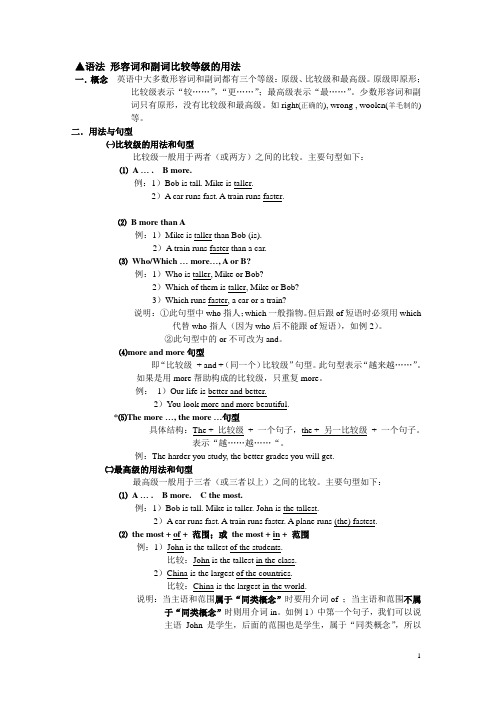
▲语法形容词和副词比较等级的用法一.概念英语中大多数形容词和副词都有三个等级:原级、比较级和最高级。
原级即原形;比较级表示“较……”,“更……”;最高级表示“最……”。
少数形容词和副词只有原形,没有比较级和最高级。
如right(正确的), wrong , woolen(羊毛制的)等。
二.用法与句型㈠比较级的用法和句型比较级一般用于两者(或两方)之间的比较。
主要句型如下:⑴A … . B more.例:1)Bob is tall. Mike is taller.2)A car runs fast. A train runs faster.⑵B more than A例:1)Mike is taller than Bob (is).2)A train runs faster than a car.⑶Who/Which … more…, A or B?例:1)Who is taller, Mike or Bob?2)Which of them is taller, Mike or Bob?3)Which runs faster, a car or a train?说明:①此句型中who指人;which一般指物。
但后跟of短语时必须用which代替who指人(因为who后不能跟of短语),如例2)。
②此句型中的or不可改为and。
⑷more and more句型即“比较级+ and +(同一个)比较级”句型。
此句型表示“越来越……”。
如果是用more帮助构成的比较级,只重复more。
例:1)Our life is better and better.2)You look more and more beautiful.*⑸The more …, the more …句型具体结构:The + 比较级+ 一个句子,the + 另一比较级+ 一个句子。
表示“越……越……“。
例:The harder you study, the better grades you will get.㈡最高级的用法和句型最高级一般用于三者(或三者以上)之间的比较。
初中英语知识点归纳形容词副词的比较级和最高级

初中英语知识点归纳形容词副词的比较级和最高级形容词和副词的比较级和最高级是初中英语学习中的重要知识点。
它们用于描述事物的程度、大小、速度等,并且在日常生活和书面表达中经常被使用。
在本文中,我将归纳总结形容词和副词的比较级和最高级的用法和构成规则,以便初中生对此有一个清晰的了解。
一、形容词的比较级和最高级用法1. 形容词的比较级用于比较两个人或事物的性质、状态、特征等。
构成方法如下:1) 单音节形容词和部分双音节形容词在后面加-er,如tall(高)- taller(更高)。
2) 以不发音的e结尾的形容词后面直接加-r,如nice(好看)- nicer (更好看)。
3) 以辅音字母+y结尾的形容词把y变为i,再加-er,如happy(快乐)- happier(更快乐)。
4) 大部分双音节形容词前面加more,如beautiful(美丽)- more beautiful(更美丽)。
例如:- My sister is taller than me.(我妹妹比我高。
)- This book is more interesting than that one.(这本书比那本书更有趣。
)2. 形容词的最高级用于比较三个或三个以上人或事物的性质、状态、特征等。
构成方法如下:1) 单音节形容词和部分双音节形容词在后面加-est,如tall(高)- tallest(最高)。
2) 以不发音的e结尾的形容词后面直接加-st,如nice(好看)- nicest(最好看)。
3) 以辅音字母+y结尾的形容词把y变为i,再加-est,如happy(快乐)- happiest(最快乐)。
4) 大部分双音节形容词前面加most,如beautiful(美丽)- most beautiful(最美丽)。
例如:- Tom is the tallest student in our class.(汤姆是我们班最高的学生。
)- This is the most delicious food I have ever tasted.(这是我尝过的最美味的食物。
形容词和副词比较级和最高级的用法总结

形容词和副词原级,最高级和比较级用法一、原级的用法1.只能修饰原级的词:very,quite,so,too例如,He is too tired to walk on.他太累了以至于不能再继续走了。
My brother runs so fast that I can‘t follow him.我弟弟跑得那么快以至于我跟不上他。
2.比较级常用的句型结构(1)“甲+be+(倍数)+形容词比较级+than+乙”表示“甲比乙…”或“甲比乙…几倍”例如,Tom is taller than Kate.汤姆比凯特高。
This room is three times bigger than that one.这个房间比那个大三倍。
“甲+实意动词+(倍数)+副词比较级+than+乙”表示“甲比乙…”或“甲比乙…几倍”例如,I got up earlier than my mother this morning.我今天早晨起床比我妈妈还早。
He runs three times faster than his brother.他跑的速度比他弟弟快三倍。
“甲+情态动词+实意动词原形+(倍数)+副词比较级+than+乙”表示“甲比乙…”或“甲比乙…几倍”(2)“甲+be+形容词比较级+than+any other+单数名词(+介词短语)”表示“甲比同一范围的任何一个人/物都……”,含义是“甲最……”。
(运用比较级表达最高级的句型)The Yangtze River is longer than any other river in China.=The Yangtze River is longer than any of the other rivers in China.长江比中国的任何一条其他的河都长。
=The Yangtze River is longer than the other rivers in China.长江比中国的其他所有的河都长。
形容词、副词的比较级和最高级的用法:

形容词、副词的比较级和最高级的用法:当两种物体之间相互比较时,我们要用形容词或副词的比较级;当相互比较的物体是三个或三个以上时,我们就要用形容词或副词的最高级形容词、副词的比较级和最高级的变化规律:1. 单音节形容词或副词后面直接加-er 或-esttall —taller —tallest fast —faster —fastest2. 以-e结尾的单音节形容词或副词直接加-r或-stlarge —larger —largest nice —nicer —nicest3. 以-y结尾的形容词或副词,改-y为-i再加-er或-estbusy—busier —busiest early —earlier —earliest4. 形容词或副词是重读闭音节时,双写最后的辅音字母,再加-er或-esthot —hotter —hottest big —bigger —biggest5. 多音节形容词或副词前面直接加more或mostdelicious —more delicious —most deliciousbeautiful —more beautiful —most beautiful6. 不规则变化good (well) —better —best bad (badly) —worse—worst形容词、副词的比较级和最高级的句子公式:比较级形容词物体A + am / are / is + 形比+ than + 物体B.I am taller than you.Pasta is more delicious than pizza.副词物体A + 行为动词+ 副比+ than + 物体B.Cheetahs run faster than goats.He studies better than me.最高级1)物体A + am / are / is + the + 形最高级+ 比较范围(of + 人/ 物,in +地方).I am the tallest in the class.地方) Pasta is the most delicious food of the three.2)物体 A + 行为动词 + 副词最高级 + 比较范围( of + 人/ 物, in + Cheetahs run fastest in the world.He studies best of us.一 . 词形变换。
- 1、下载文档前请自行甄别文档内容的完整性,平台不提供额外的编辑、内容补充、找答案等附加服务。
- 2、"仅部分预览"的文档,不可在线预览部分如存在完整性等问题,可反馈申请退款(可完整预览的文档不适用该条件!)。
- 3、如文档侵犯您的权益,请联系客服反馈,我们会尽快为您处理(人工客服工作时间:9:00-18:30)。
形容词和副词比较级和最高级的用法
集团文件发布号:(9816-UATWW-MWUB-WUNN-INNUL-DQQTY-
一、原级的用法
1.只能修饰原级的词:very,quite,so,too
例如,He is too tired to walk on.他太累了以至于不能再继续走了。
My brother runs so fast that I can‘t follow him.我弟弟跑
得那么快以至于我跟不上他。
2.原级常用的句型结构
(1)“甲+be+(倍数)+as+形容词原级+as+乙”表示“甲和乙程度相同”或“甲是乙的几倍”
例如,Tom is as old as Kate.汤姆和凯特年龄一样大。
Tom is twice as old as Kate.汤姆的年龄是凯特的二倍。
“甲+实意动词+(倍数)+as+副词原级+as+乙”表示“甲和乙程度相同”或“甲是乙的几倍”
例如,Tom runs as fast as Mike.汤姆和迈克跑得一样快。
Tom runs twice as fast as Mike.汤姆跑得速度是迈克的二倍。
(2)“甲+be+not+as/so+形容词原级+as+乙”甲不如乙…
例如,This room is not as/so big as that one. 这个房间不如那个大。
“甲+助动词+not+动词原形+as/so+副词原级+as+乙”甲不如乙…
例如,He doesn’t walk as slowly as you.他走路不像你那样慢。
二、比较级的用法
1.可以修饰比较级的词:much,a lot,far,…的多 a little,a bit,…一点儿
even甚至,still仍然
Lesson One is much easier than Lesson Two.第一课比第二课容易得多。
Tom looks even younger than before.汤姆甚至比以前更年轻。
This train runs much faster than that one.这辆火车比那辆跑地快。
She drives still more carefully than her husband.她开车仍然比她丈夫还认真。
2.比较级常用的句型结构
(1)“甲+be+(倍数)+形容词比较级+than+乙”表示“甲比乙…”或“甲比乙…几倍”
例如,Tom is taller than Kate.汤姆比凯特高。
This room is three times bigger than that one.这个房间比那个大三倍。
“甲+实意动词+(倍数)+副词比较级+than+乙”表示“甲比乙…”或“甲比乙…几倍”
例如,I got up earlier than my mother this morning.我今天早晨起床比我妈妈还早。
He runs three times faster than his brother.他跑的速度比他弟弟快三倍。
(2)“甲+be+形容词比较级+than+any other+单数名词(+介词短语)”表示“甲比同一范围的任何一个人/物都……”,含义是“甲最……”。
The Yangtze River is longer than any other river in China.
=The Yangtze River is longer than any of the other rivers in China.长江比中国的任何一条其他的河都长。
=The Yangtze River is longer than the other rivers in China.长江比中国的其他所有的河都长。
=The Yangtze River is the longest river in China.长江是中国最长的河流。
注意:The Yangtze River is longer than any river in Japan.长江比日本的任何一条河都长。
“甲+实意动词+副词比较级+than+any other+单数名词(+介词短语)”表示“甲比同一范围的任何一个人/物都……”,含义是“甲最……”。
例如,Mike gets to school earlier than any other student in his class.
= Mike gets to school earlier than any of the other students in his class.迈克比他们班上任何一个其他的同学到校都早。
= Mike gets to school earlier than the other students in his class.迈克比他们班上其他的同学到校都早。
= Mike gets to school earliest in his class.迈克在他们班到校最早。
注意:Mike gets to school earlier than any student in Tom’s class.迈克比汤姆班上任何一个学生到校都早。
(迈克和汤姆不是同一个班)
(3)“甲+be+the+形容词比较级+of the two+……”表示“甲是两者中较……的”。
例如,Look at the two boys. My brother is the taller of the two.看那两个男孩,我弟弟是两个当中较高的那个。
(4)“比较级+and+比较级”表示“越来越……”。
例如,He is getting taller and taller.他变得越来越高了。
The flowers are more and more beautiful.花儿越来越漂亮。
He does his homework more and more carefully.他做作业越来越认真了。
(5)“t he+比较级,the+比较级”表示“越……,越……”。
例如,The more careful you are,the fewer mistakes you’ll make.你越认真,犯的错误越少。
(6)“特殊疑问词+be+形容词比较级,甲or乙”
例如,Which is bigger,the earth or the moon哪一个大,地球还是
月球
“特殊疑问词+实意动词+副词比较级,甲or乙”
例如,Who draws better,Jenny or Danny谁画得比较好,詹妮还是丹
尼
3.最高级常用句型结构
(1)“主语+be+the+形容词最高级+单数名词+in/of短语”表示“……是……中最……的”。
例如,Tom is the tallest in his class./of all the students.汤姆是他们班上/所有学生当中最高的。
This apple is the biggest of the five.这个苹果是五个当中最大的。
“主语+实意动词+(the)+副词最高级+单数名词+in/of短语”表示“……是……中最……的”。
例如,I jump (the) farthest in my class.我是我们班跳得最远的。
(2)“主语+be+oneofthe+形容词最高级+复数名词+in/of短语”表示“……是……中最……之一”。
例如,Beijing is one of the largest cities in China.北京是中国最大城市之一。
(3)“特殊疑问词+be+the+最高级+甲,乙,or丙”用于三者以上的比较。
例如,Which country is the largest,China,Brazil or Canada哪一个国家最大,中国,巴西还是加拿大
“特殊疑问词+be+the+副词最高级+甲,乙,or丙”用于三者以上的比较例如,Which season do you like (the) best,spring,summer or autumn你最喜欢哪一个季节,春天,夏天还是秋天。
